Physical Properties and Storage Stability of Buton Rock Asphalt Modified Asphalt
Abstract
:1. Introduction
2. Materials and Experimental Methods
2.1. Materials
2.2. Preparation of BRA-MA
2.3. Experimental Methods
3. Results and Discussions
3.1. Physical Properties of BRA-MA
3.1.1. Softening Point
3.1.2. Penetration
3.1.3. Ductility
3.1.4. Viscosity and Viscosity-Temperature Susceptibility (VTS)
3.2. Storage-Stability Evaluation Determination
3.2.1. Softening Point Difference
3.2.2. IS Based on the Viscosity Difference
3.3. Static Storage Stability in the Production Plant
3.4. Storage Stability during Transportation
4. Conclusions
- (1)
- Softening point was positively correlated to BRA content, while the particle size of BRA showed a negative correlation. Penetration of BRA-MA increased as the increment in particle size, while BRA content negatively affected penetration. Both BRA content and particle size negatively determines the ductility of BRA-MA. A larger particle size of BRA resulted in lower viscosity, but a higher BRA content increased the viscosity of BRA-MA. The temperature susceptibility of BRA-MA decreased with the increase in BRA content, but the smaller particle size led to lower temperature susceptibility.
- (2)
- Separating-tube method was used to simulate the segregation of BRA-MA in Lab. How BRA-content influence on storage stability could not be significantly reflected by the softening-point difference test, and the segregation degree was not quantitively revealed. The IS value based on the viscosity difference test had a higher statistical significance when evaluating the influence of BRA content and particle size on segregation. The segregation of asphalt with different original viscosity could be quantitatively compared through the IS value based on the viscosity difference test.
- (3)
- Storage stabilities of static and transportation corresponded to storage in a production plant and during the vehicle transportation process. The segregation of BRA-MA illustrated a rising trend as the BRA coffintent and particle size increased. Both storage temperature and time were positively correlated to the segregation of BRA-MA. It was proved that the relationship between the specific surface area and segregation were power functional. This relationship can be used to understand how particle size, which is correlated to specific surface area, determines the segregation of BRA-MA. Based on the simulated experiment of transportation segregation, BRA-MA with BRA-1~4 whose d(0.5) particle sizes ere lower than 13.6 μm, showed low segregation. However, the segregation of BRA-MA with BRA whose d(0.5) particle size was over 106 μm was severe.
Author Contributions
Funding
Institutional Review Board Statement
Informed Consent Statement
Data Availability Statement
Acknowledgments
Conflicts of Interest
References
- Ky, A.; Wla, B.; Ly, C.; Jo, A.; Man, Z. Evaluation of waste cooling oil and European Rock Asphalt modified asphalt with laboratory tests and economic cost comparison—ScienceDirect. J. Clean. Prod. 2021, 310, 127364. [Google Scholar]
- Suaryana, N. Performance evaluation of stone matrix asphalt using indonesian natural rock asphalt as stabilizer. Int. J. Pavement Res. Technol. 2016, 9, 387–392. [Google Scholar] [CrossRef] [Green Version]
- Liu, C.; Lv, S.; Jin, D.; Qu, F. Laboratory Investigation for the Road Performance of Asphalt Mixtures Modified by Rock Asphalt-Styrene Butadiene Rubber. J. Mater. Civ. Eng. 2020, 33, 04020504. [Google Scholar] [CrossRef]
- Liu, H.; Zhang, Z.; Li, Z.; Li, N. Effects of polyphosphoric acid (PPA), styrene-butadiene: Tyrene (SBS), or rock asphalt on the performance of desulfurized rubber modified asphalt. J. Appl. Polym. Sci. 2021, 138, 50621. [Google Scholar] [CrossRef]
- Wen, Y.; Guo, N.; Wang, L.; Jin, X.; Wen, H. Assessment of various fatigue life indicators and fatigue properties of rock asphalt composite. Constr. Build. Mater. 2021, 289, 123147. [Google Scholar] [CrossRef]
- Fan, X.; Lu, W.; Lv, S.; He, F. Improvement of Low-Temperature Performance of Buton Rock Asphalt Composite Modified Asphalt by Adding Styrene-Butadiene Rubber. Materials 2019, 12, 2358. [Google Scholar] [CrossRef] [Green Version]
- Lv, S.; Peng, X.; Liu, C.; Qu, F.; Zhu, X.; Tian, W.; Zheng, J. Aging resistance evaluation of asphalt modified by Buton-rock asphalt and bio-oil based on the rheological and microscopic characteristics. J. Clean. Prod. 2020, 257, 120589. [Google Scholar] [CrossRef]
- Ming, W.A.; Cx, B. Evaluation of microstructural features of Buton rock asphalt components and rheological properties of pure natural asphalt modified asphalt. Constr. Build. Mater. 2020, 267, 121132. [Google Scholar]
- Yang, C.; Wu, S.; Cui, P.; Amirkhanian, S.; Zhao, Z.; Wang, F.; Zhang, L.; Wei, M.; Zhou, X.; Xie, J. Performance characterization and enhancement mechanism of recycled asphalt mixtures involving high RAP content and steel slag. J. Clean. Prod. 2022, 336, 130484. [Google Scholar] [CrossRef]
- Wan, J.; Wu, S.; Xiao, Y.; Fang, M.; Song, W.; Pan, P.; Zhang, D. Enhanced ice and snow melting efficiency of steel slag based ultra-thin friction courses with steel fiber. J. Clean. Prod. 2019, 236, 117613. [Google Scholar] [CrossRef]
- Xue, Y.; Wei, X.; Zhao, H.; Wang, T.; Xiao, Y. Interaction of spent FCC catalyst and asphalt binder: Rheological properties, emission of VOCs and immobilization of metals. J. Clean. Prod. 2020, 259, 120830. [Google Scholar] [CrossRef]
- Cui, P.; Wu, S.; Xiao, Y.; Hu, R.; Yang, T. Environmental performance and functional analysis of chip seals with recycled basic oxygen furnace slag as aggregate. J. Hazard. Mater. 2020, 405, 124441. [Google Scholar] [CrossRef] [PubMed]
- Wang, F.; Xie, J.; Wu, S.; Li, J.; Zhang, L. Life cycle energy consumption by roads and associated interpretative analysis of sustainable policies. Renew. Sustain. Energy Rev. 2021, 141, 110823. [Google Scholar] [CrossRef]
- Leviton, A.; Pallansch, M.J. High-Temperature Short-Time Sterilized Evaporated Milk. III. The Influence of the Lipid Phase on Heat and Storage Stability. J. Dairy Sci. 1961, 44, 633–643. [Google Scholar] [CrossRef]
- Yang, Z.; Kumar, A.; Huhnke, R.L. Review of recent developments to improve storage and transportation stability of bio-oil. Renew. Sustain. Energy Rev. 2015, 50, 859–870. [Google Scholar] [CrossRef]
- Galooyak, S.S.; Dabir, B.; Nazarbeygi, A.E.; Moeini, A. Rheological properties and storage stability of bitumen/SBS/montmorillonite composites. Constr. Build. Mater. 2010, 24, 300–307. [Google Scholar] [CrossRef]
- Yoshida, H.; Zhang, G.Z.; Kitamura, T.; Kawai, T. Compatibility of Polymer Blends Evaluated by Crystallization Dynamics. Simultaneous DSC-FTIR method. J. Therm. Anal. Calorim. 2001, 64, 577–583. [Google Scholar] [CrossRef]
- Gu, Y.; Tang, B.; He, L.; Yang, F.; Wang, H.; Ling, J. Compatibility of cured phase-inversion waterborne epoxy resin emulsified asphalt. Constr. Build. Mater. 2019, 229, 116942. [Google Scholar] [CrossRef]
- Xiaolong, Z.; Aimin, S.; Biao, D.; Yuqiao, T.; Xiaonan, H. Evaluation and Analysis of Variance of Storage Stability of Asphalt Binder Modified by Nanotitanium Dioxide. Adv. Mater. Sci. Eng. 2017, 2017, 6319697. [Google Scholar]
- Navarro, F.J.; Partal, P.; Martınez-Boza, F.; Gallegos, C. Thermo-rheological behaviour and storage stability of ground tire rubber-modified bitumens. Fuel 2004, 83, 2041–2049. [Google Scholar] [CrossRef]
- Ming, L.; Xue, X.; Fan, W.; Sun, H.; Yan, Y.; Xing, B. Viscous properties, storage stability and their relationships with microstructure of tire scrap rubber modified asphalt. Constr. Build. Mater. 2015, 74, 124–131. [Google Scholar]
- Fang, C.; Pei, L.; Yu, R.; Liu, X. Preparation process to affect stability in waste polyethylene-modified bitumen. Constr. Build. Mater. 2014, 54, 320–325. [Google Scholar] [CrossRef]
- Ym, A.; Pp, A.; Wei, H.A.; Mz, A.; Bh, B. Quantifying the effective mobilized RAP content during hot in-place recycling techniques. J. Clean. Prod. 2021, 314, 127953. [Google Scholar]
- Wang, R.; Xiong, Y.; Yue, M.; Hao, M.; Yue, J. Investigating the effectiveness of carbon nanomaterials on asphalt binders from hot storage stability, thermodynamics, and mechanism perspectives. J. Clean. Prod. 2020, 276, 124180. [Google Scholar] [CrossRef]
- Zhang, R.; Wang, H.; Jiang, X.; You, Z.; Yang, X.; Ye, M. Thermal Storage Stability of Bio-Oil Modified Asphalt. J. Mater. Civ. Eng. 2018, 30, 04018054. [Google Scholar] [CrossRef]
- Feih, S.; Manatpon, K.; Mathys, Z.; Gibson, A.G.; Mouritz, A.P. Strength degradation of glass fibers at high temperatures. J. Mater. Ence 2009, 44, 392–400. [Google Scholar] [CrossRef]
- Liu, W.; Li, H.; Lin, H.; Du, X.; Liu, S. Effects of a Fuel-Resistant Modifier on the High-Temperature Characteristics of Asphalt Binders. Sustainability 2021, 13, 7924. [Google Scholar] [CrossRef]
- Rasmussen, R.O.; Lytton, R.L.; Chang, G.K. Method to Predict Temperature Susceptibility of an Asphalt Binder. J. Mater. Civ. Eng. 2002, 14, 246–252. [Google Scholar] [CrossRef]
- Wang, P.; Yong, W.; Zhao, K.; Dan, C.; Wong, A. Evolution and locational variation of asphalt binder aging in long-life hot-mix asphalt pavements. Constr. Build. Mater. 2014, 68, 172–182. [Google Scholar] [CrossRef]
- Zhao, X.; Yan, K.; Yang, S.; Peng, H. Laboratory Research on the Properties of Warm Amorphous Poly Alpha Olefin–Modified Asphalt Mixture Using Sasobit and Deurex. J. Mater. Civ. Eng. 2018, 30, 04018076. [Google Scholar] [CrossRef]
- Zhang, C.; Yu, J.; Xue, L.; Sun, Y. Investigation of γ-(2,3-Epoxypropoxy)propyltrimethoxy Silane Surface Modified Layered Double Hydroxides Improving UV Ageing Resistance of Asphalt. Materials 2017, 10, 78. [Google Scholar] [CrossRef] [PubMed]
- Hallmark-Haack, B.L.; Hernandez, N.B.; Williams, R.C.; Cochran, E. Ground Tire Rubber Modification for Improved Asphalt Storage Stability. Energy Fuels 2019, 33, 2659–2664. [Google Scholar] [CrossRef]
- Zhu, Y.; Zhang, J.; Si, C.; Yan, T.; Li, Y. Laboratory Evaluation on Performance of Recycled Asphalt Binder and Mixtures under Short-Term Aging Conditions. Sustainability 2021, 13, 3404. [Google Scholar] [CrossRef]


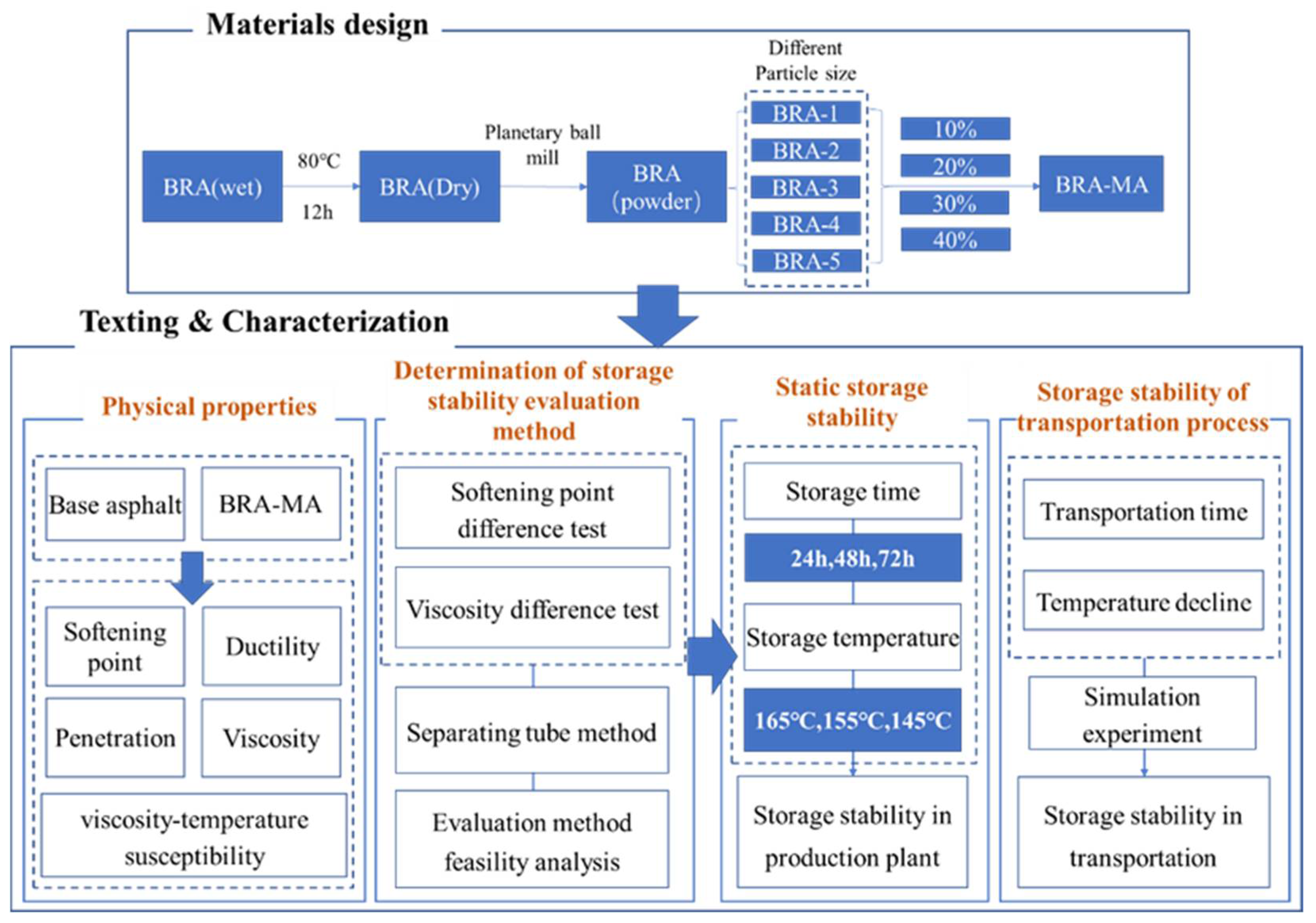

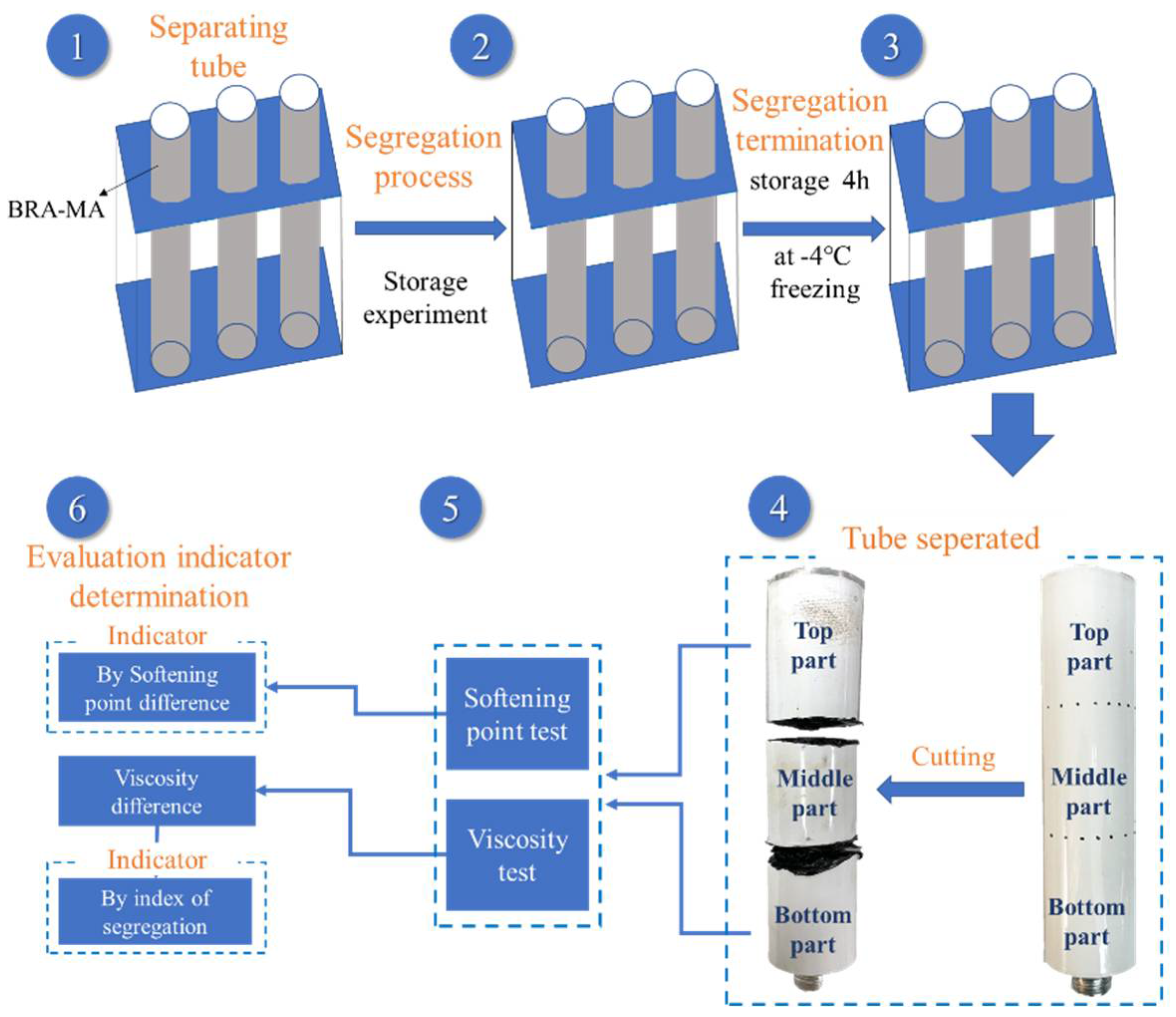


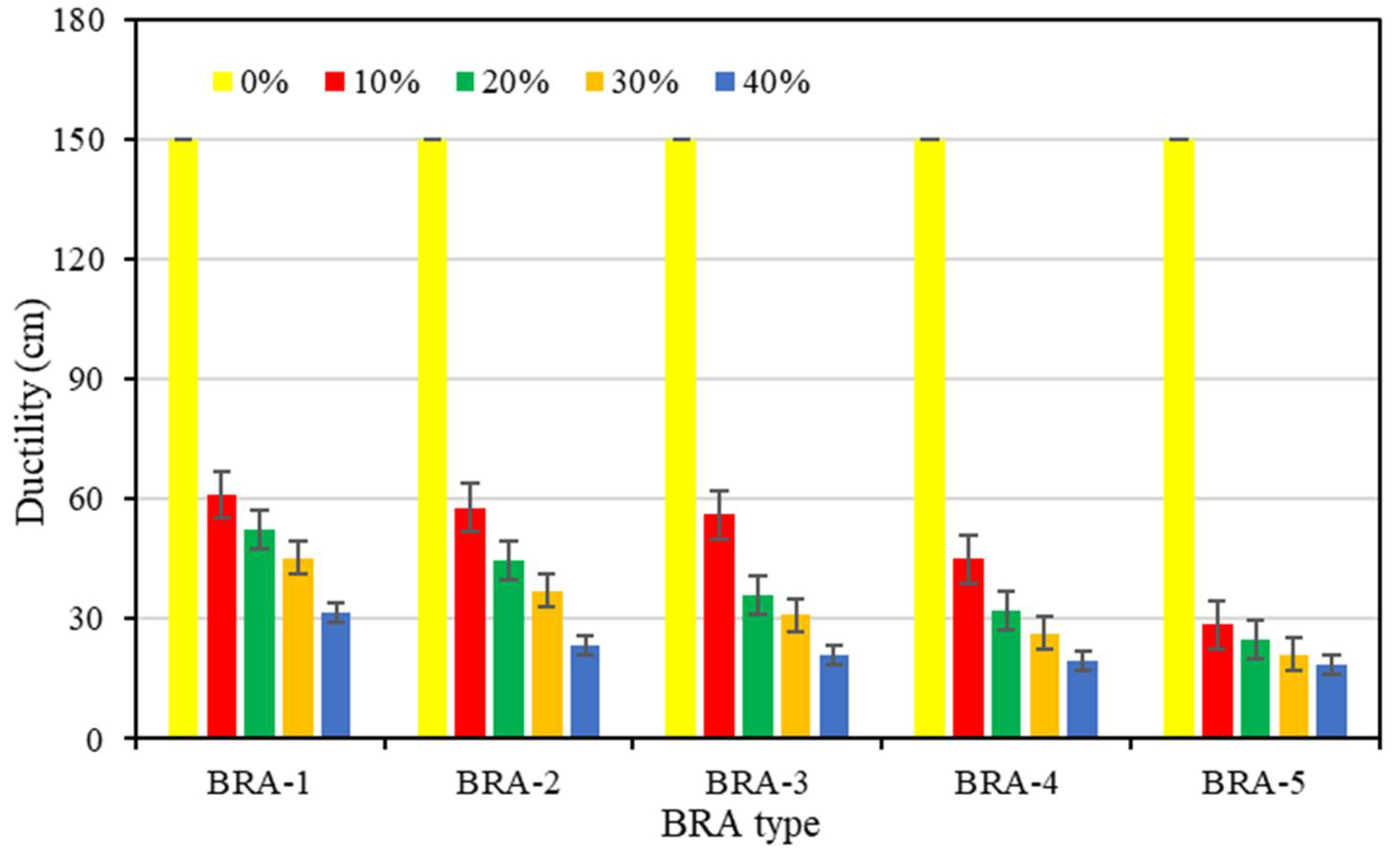


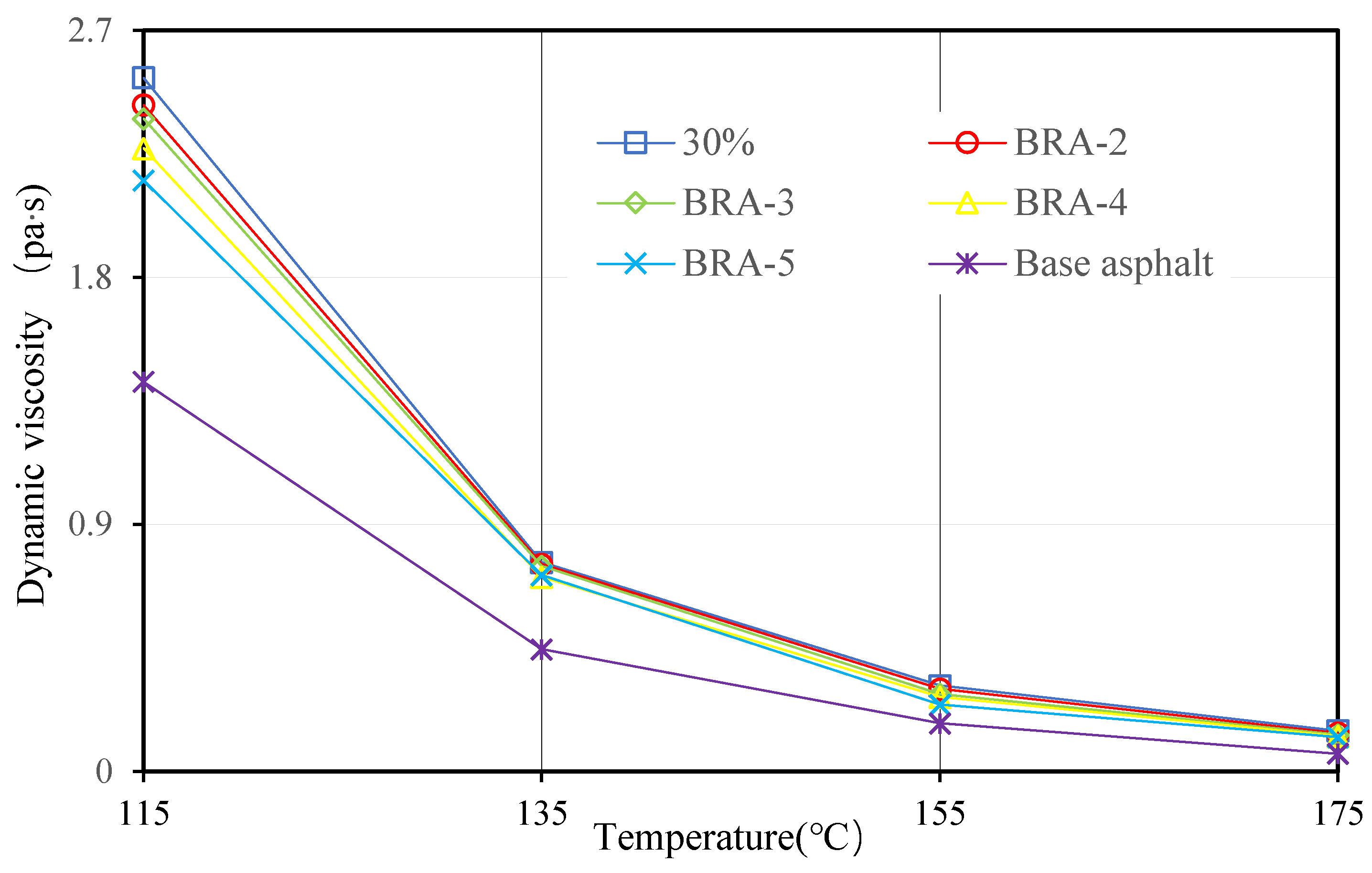
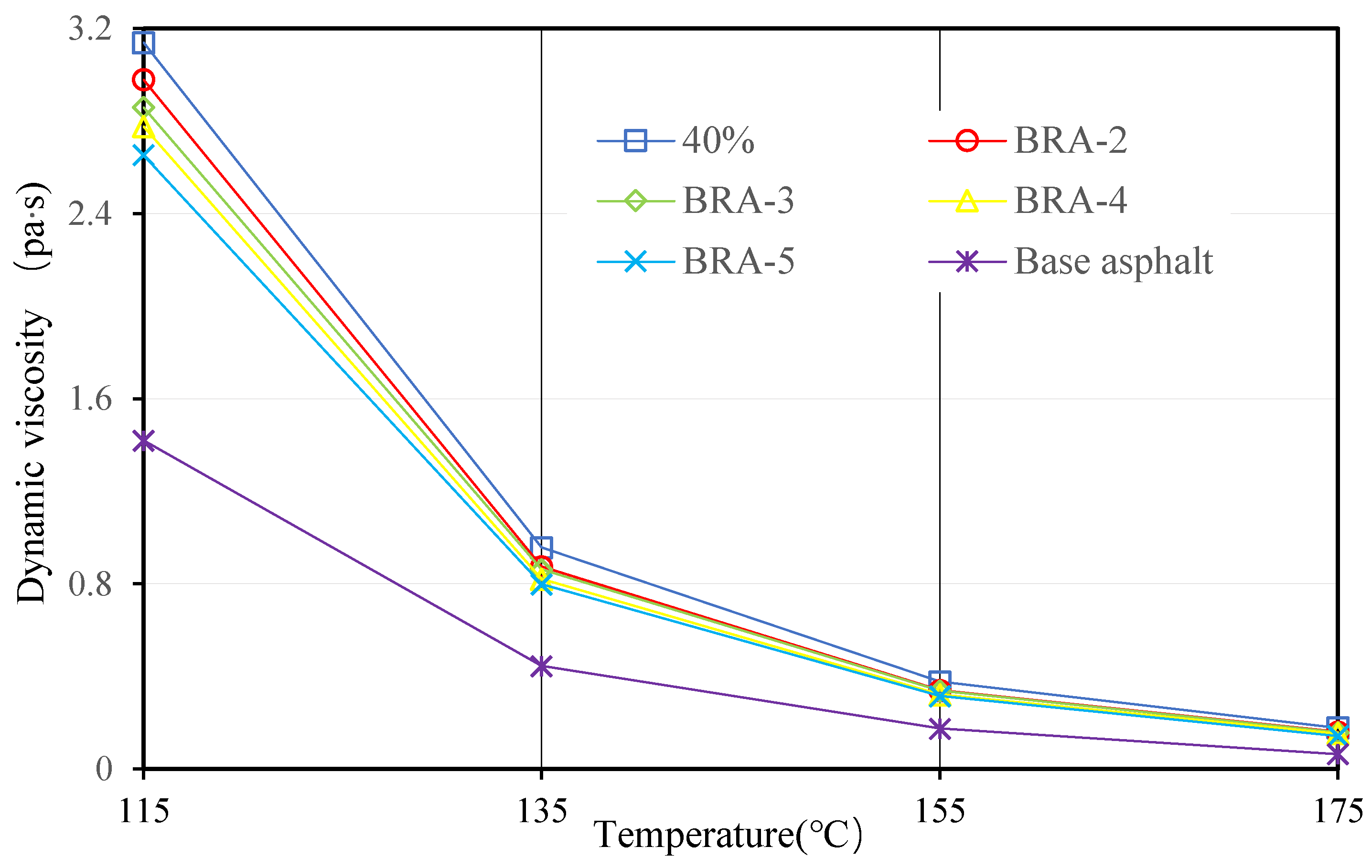

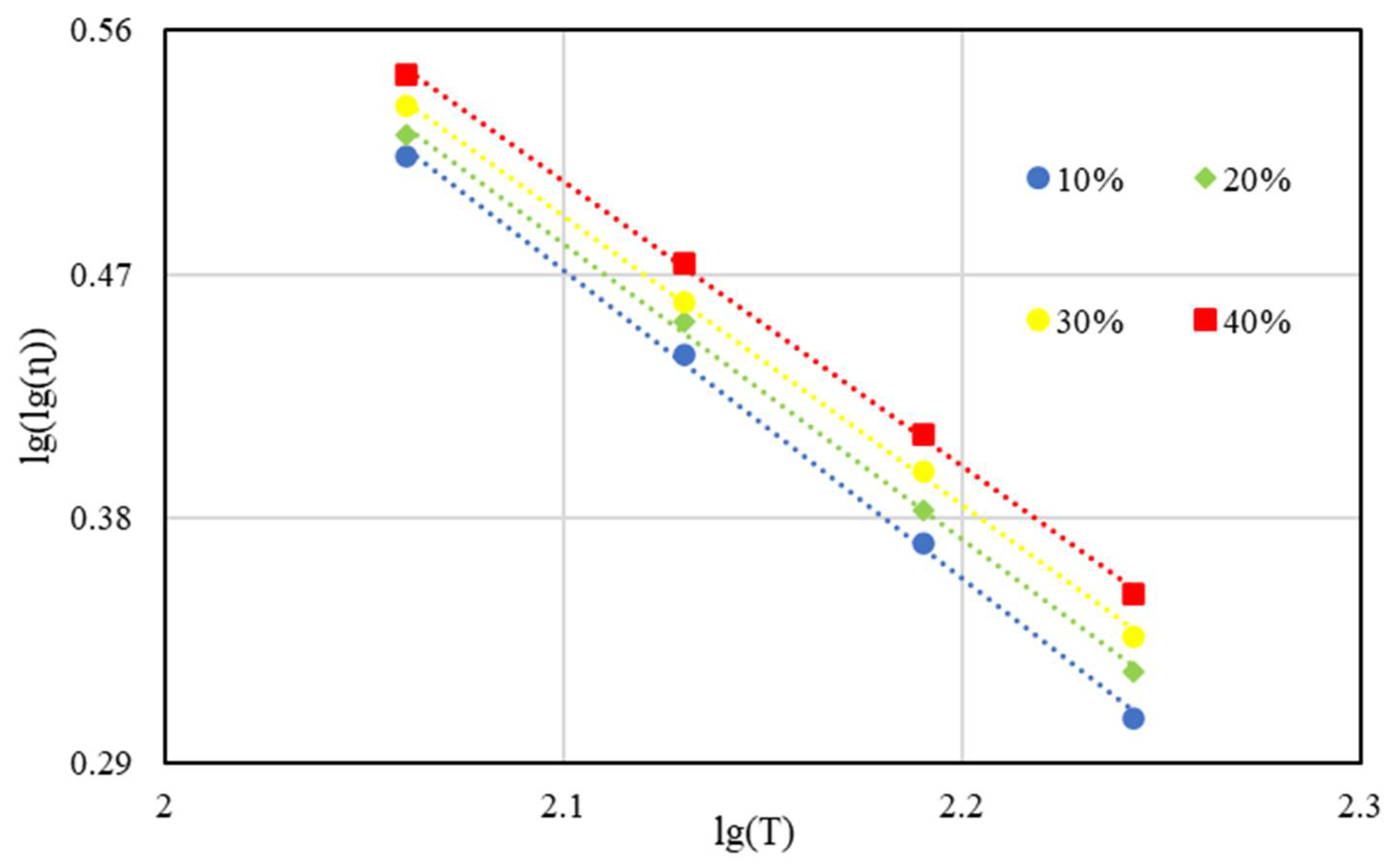

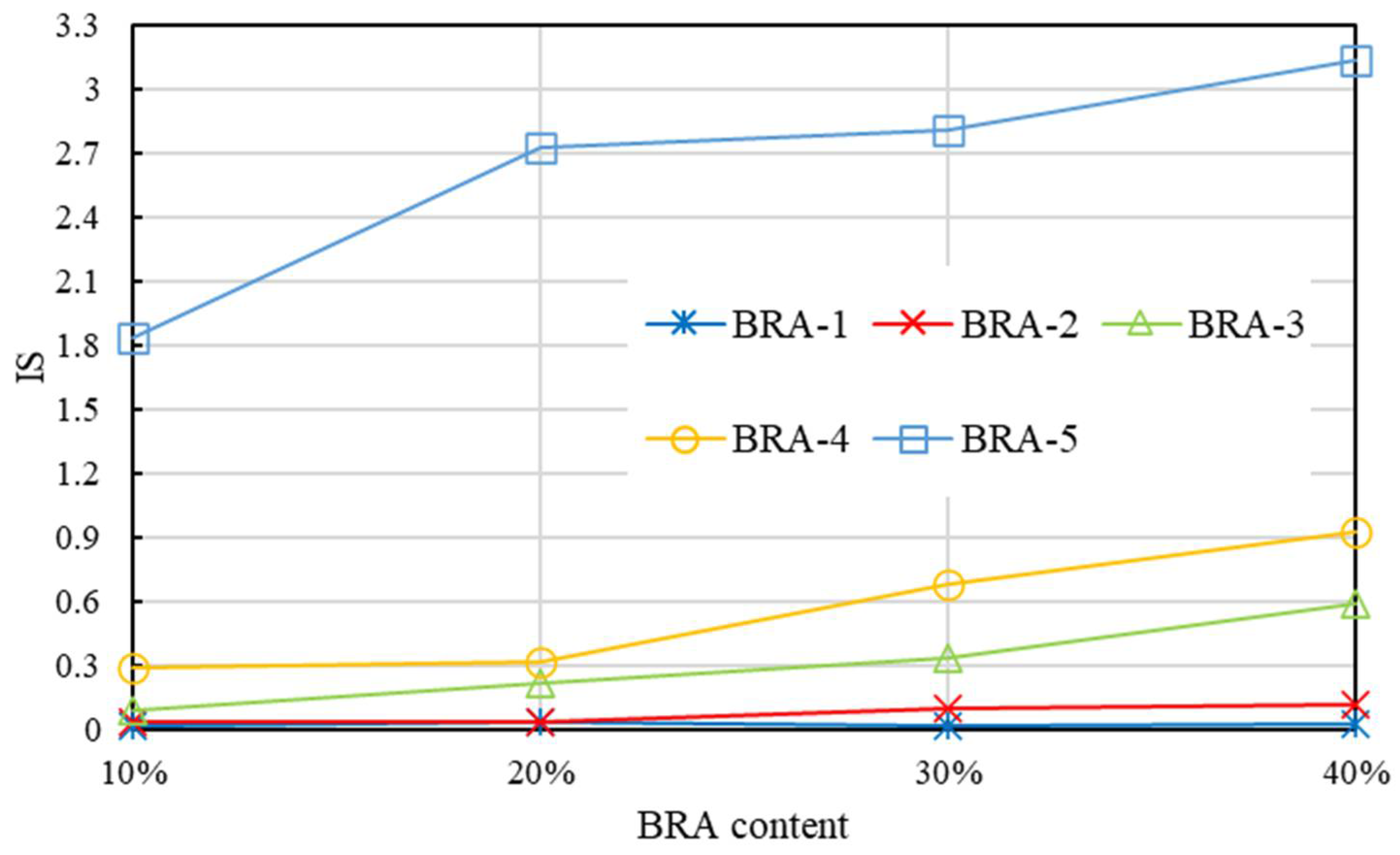


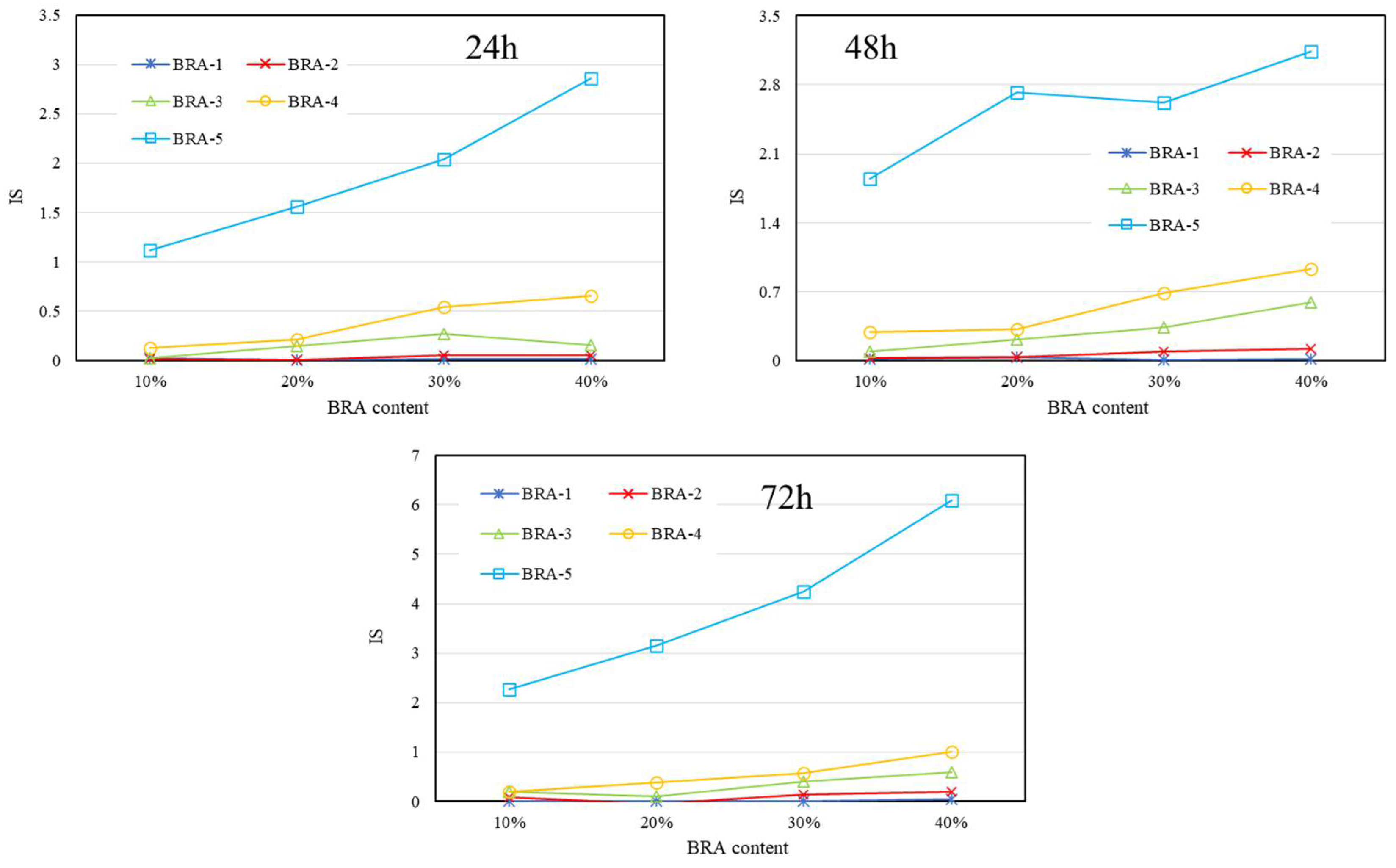
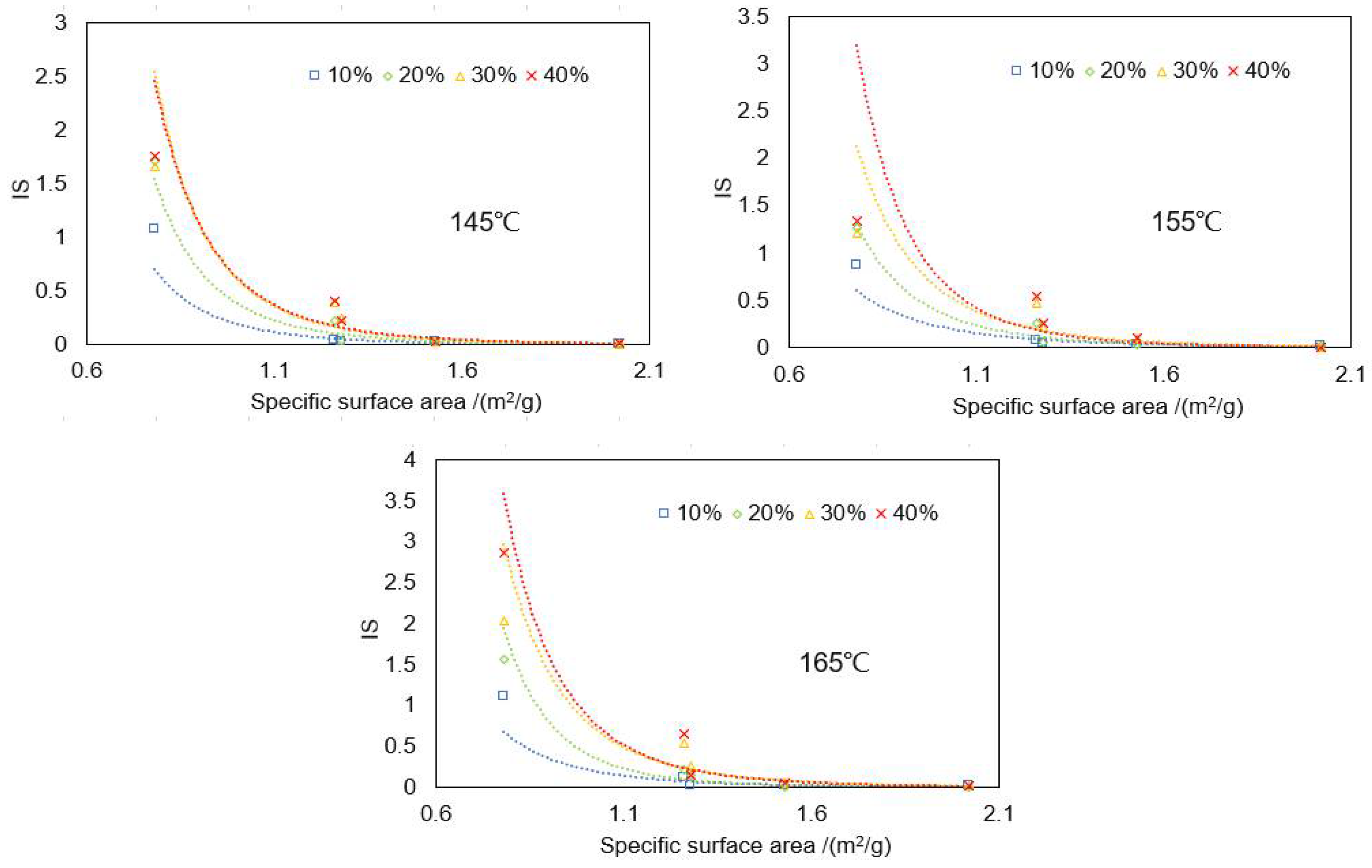
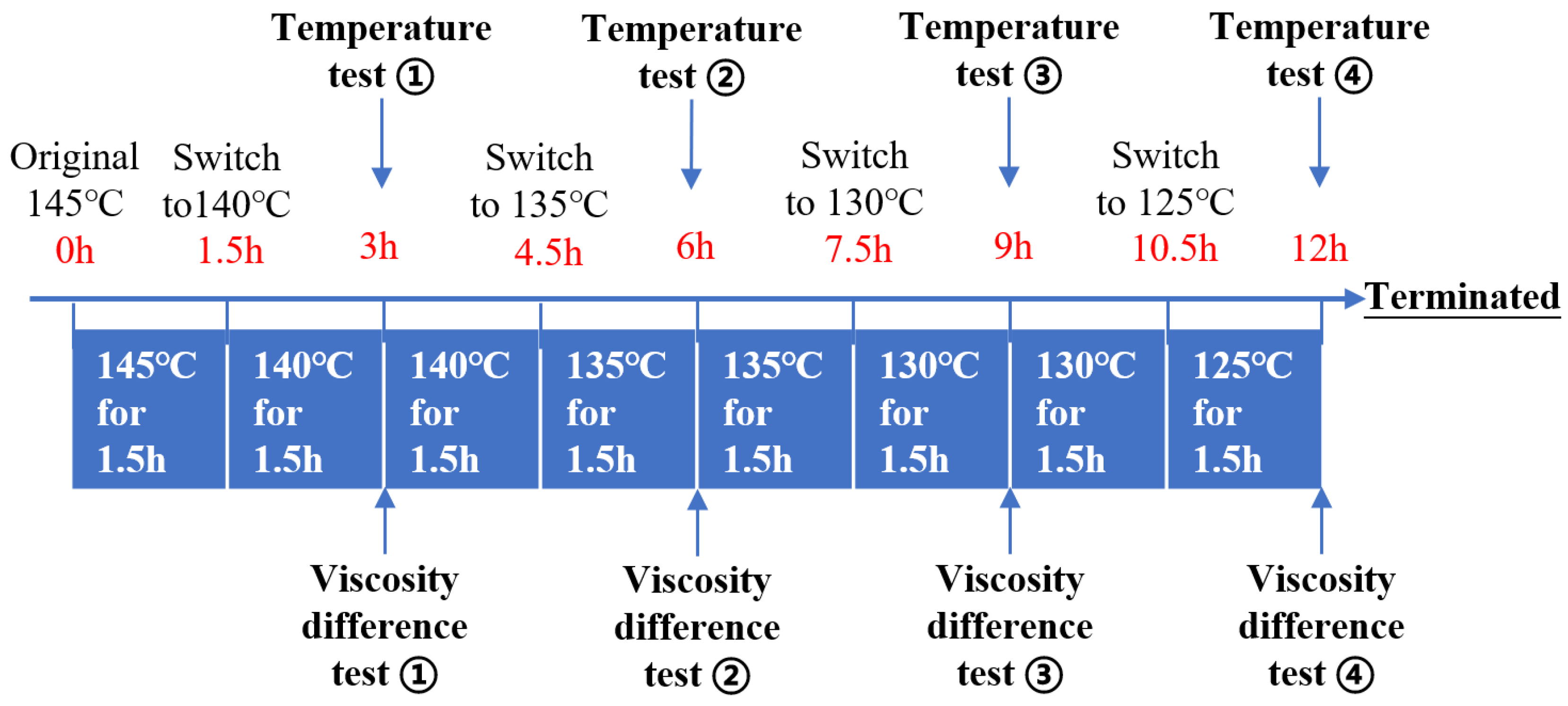
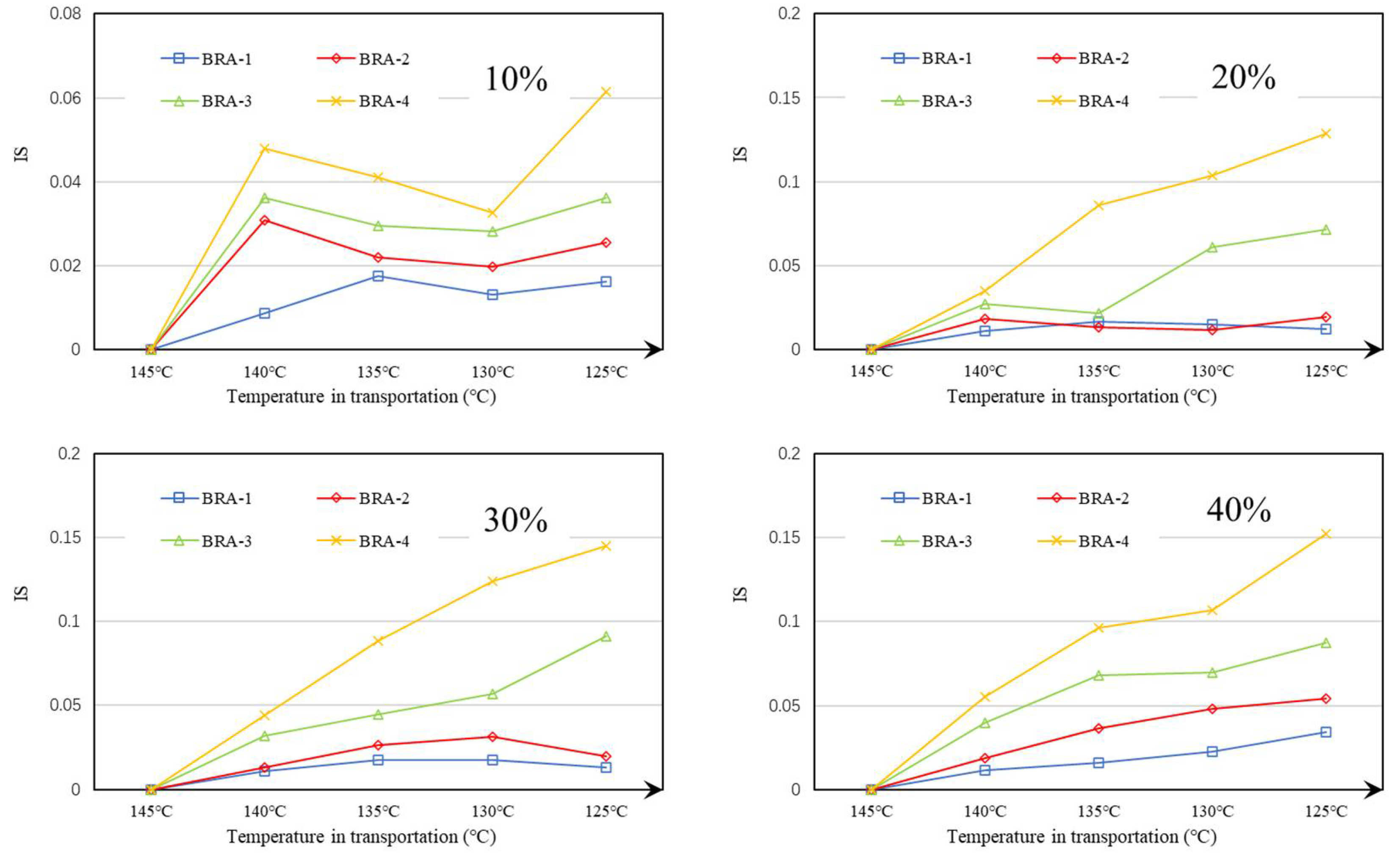

| Properties | Penetration (25 °C, 100 g, 5 s) | Softening Point | Ductility (5 cm/min, 15 °C) | Brookfield Viscosity (10 r/min, 135 °C) |
|---|---|---|---|---|
| Unit | 0.1 mm | (°C) | cm | Pa·s |
| Base asphalt | 71.2 | 48.8 | ≥100 | 0.142 |
| Standard limits | 60~80 | ≥46.0 | ≥100 | - |
| BRA Number | d(0.1) (μm) | d(0.5) (μm) | d(0.9) (μm) | Specific Surface Area (m2/g) |
|---|---|---|---|---|
| BRA-1 | 1.20 | 6.26 | 21.07 | 2.02 |
| BRA-2 | 1.84 | 9.55 | 23.87 | 1.53 |
| BRA-3 | 2.39 | 12.58 | 32.27 | 1.28 |
| BRA-4 | 2.26 | 13.60 | 37.64 | 1.26 |
| BRA-5 | 75.29 | 106.22 | 150.55 | 0.78 |
| BRA-1 | BRA-2 | BRA-3 | BRA-4 | BRA-5 | |
|---|---|---|---|---|---|
| 0% | 1.297 | 1.297 | 1.297 | 1.297 | 1.297 |
| 10% | 1.135 | 1.117 | 1.128 | 1.164 | 1.176 |
| 20% | 1.087 | 1.112 | 1.114 | 1.147 | 1.166 |
| 30% | 1.066 | 1.083 | 1.104 | 1.107 | 1.120 |
| 40% | 1.048 | 1.074 | 1.075 | 1.081 | 1.097 |
| Temperature (°C) | BRA Content (%) | Power Function Curve-Fitting Equation | R2 |
|---|---|---|---|
| 145 | 10 | y = 0.1929x− 5.216 | 0.9968 |
| 20 | y = 0.3852x− 5.58 | 0.9930 | |
| 30 | y = 0.6138x− 5.727 | 0.9672 | |
| 40 | y = 0.6268x− 5.505 | 0.9737 | |
| 155 | 10 | y = 0.2284x− 3.913 | 0.9935 |
| 20 | y = 0.3813x− 4.937 | 0.9816 | |
| 30 | y = 0.6213x− 4.967 | 0.9104 | |
| 40 | y = 0.7397x− 5.889 | 0.8968 | |
| 165 | 10 | y = 0.2222x− 4.498 | 0.9928 |
| 20 | y = 0.4174x− 6.197 | 0.9915 | |
| 30 | y = 0.8069x− 5.256 | 0.9641 | |
| 40 | y = 0.8867x− 5.629 | 0.9713 |
Publisher’s Note: MDPI stays neutral with regard to jurisdictional claims in published maps and institutional affiliations. |
© 2022 by the authors. Licensee MDPI, Basel, Switzerland. This article is an open access article distributed under the terms and conditions of the Creative Commons Attribution (CC BY) license (https://creativecommons.org/licenses/by/4.0/).
Share and Cite
Su, Y.; Hu, X.; Wan, J.; Wu, S.; Zhang, Y.; Huang, X.; Liu, Z. Physical Properties and Storage Stability of Buton Rock Asphalt Modified Asphalt. Materials 2022, 15, 3592. https://doi.org/10.3390/ma15103592
Su Y, Hu X, Wan J, Wu S, Zhang Y, Huang X, Liu Z. Physical Properties and Storage Stability of Buton Rock Asphalt Modified Asphalt. Materials. 2022; 15(10):3592. https://doi.org/10.3390/ma15103592
Chicago/Turabian StyleSu, Yue, Xiaodi Hu, Jiuming Wan, Shaopeng Wu, Yinglong Zhang, Xing Huang, and Zhangjun Liu. 2022. "Physical Properties and Storage Stability of Buton Rock Asphalt Modified Asphalt" Materials 15, no. 10: 3592. https://doi.org/10.3390/ma15103592
APA StyleSu, Y., Hu, X., Wan, J., Wu, S., Zhang, Y., Huang, X., & Liu, Z. (2022). Physical Properties and Storage Stability of Buton Rock Asphalt Modified Asphalt. Materials, 15(10), 3592. https://doi.org/10.3390/ma15103592






